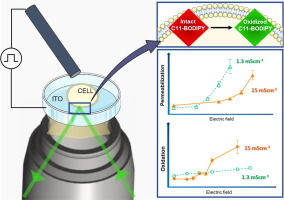当前位置:
X-MOL 学术
›
Bioelectrochemistry
›
论文详情
Our official English website, www.x-mol.net, welcomes your
feedback! (Note: you will need to create a separate account there.)
Electropermeabilization does not correlate with plasma membrane lipid oxidation.
Bioelectrochemistry ( IF 4.8 ) Pub Date : 2019-12-15 , DOI: 10.1016/j.bioelechem.2019.107433 Olga Michel 1 , Andrei G Pakhomov 2 , Maura Casciola 2 , Jolanta Saczko 3 , Julita Kulbacka 3 , Olga N Pakhomova 2
Bioelectrochemistry ( IF 4.8 ) Pub Date : 2019-12-15 , DOI: 10.1016/j.bioelechem.2019.107433 Olga Michel 1 , Andrei G Pakhomov 2 , Maura Casciola 2 , Jolanta Saczko 3 , Julita Kulbacka 3 , Olga N Pakhomova 2
Affiliation

|
The permeabilized condition of the cell membrane after electroporation can last minutes but the underlying mechanisms remain elusive. Previous studies suggest that lipid peroxidation could be responsible for the lasting leaky state of the membrane. The present study aims to link oxidation within the plasma membrane of live cells to permeabilization by electric pulses. We have introduced a method for the detection of oxidation by ratiometric fluorescence measurements of BODIPY-C11 dye using total internal reflection fluorescence (TIRF) microscopy, limiting the signal to the cell membrane. CHO-K1 cells were cultured on glass coverslips coated with an electroconductive indium tin oxide (ITO) layer, which enabled electroporation with micro- and submicrosecond pulses. No oxidation was observed with the electric field directed towards the ITO (cathode), even at field strengths much higher than that needed for permeabilization. Oxidation was readily detectable with the opposite polarity of pulses, but with the threshold higher than the permeabilization threshold. Moreover, a decrease in the medium conductance had opposite effects on permeabilization and lipid oxidation (it enhanced the former and suppressed the latter). We conclude that lipid oxidation can indeed occur at the plasma membrane after electric pulses, but it is not the cause of lasting membrane permeabilization.
中文翻译:

电通透性与质膜脂质氧化无关。
电穿孔后细胞膜的通透性状态可以持续数分钟,但是潜在的机制仍然难以捉摸。先前的研究表明,脂质过氧化作用可能是导致膜的持久泄漏状态的原因。本研究旨在通过电脉冲将活细胞质膜内的氧化与通透性联系起来。我们介绍了一种通过使用全内反射荧光(TIRF)显微镜对BODIPY-C11染料进行比例荧光测量来检测氧化的方法,从而将信号限制在细胞膜上。在涂有导电铟锡氧化物(ITO)层的玻璃盖玻片上培养CHO-K1细胞,该盖玻片可实现微秒和亚微秒脉冲的电穿孔。电场指向ITO(阴极)时未观察到氧化,即使在场强比通透性所需的场强高得多的情况下也是如此。脉冲极性相反,但阈值高于磁化阈值,很容易检测到氧化。此外,介质电导的降低对通透性和脂质氧化具有相反的影响(增强前者而抑制后者)。我们得出的结论是,电脉冲后,脂质氧化确实可以在质膜上发生,但这不是持久的膜透化的原因。介质电导的降低对通透性和脂质氧化具有相反的影响(增强前者而抑制后者)。我们得出的结论是,电脉冲后,脂质氧化确实可以在质膜上发生,但这不是持久的膜透化的原因。介质电导的降低对通透性和脂质氧化具有相反的影响(增强前者而抑制后者)。我们得出的结论是,电脉冲后,脂质氧化确实可以在质膜上发生,但这不是持久的膜透化的原因。
更新日期:2019-12-17
中文翻译:

电通透性与质膜脂质氧化无关。
电穿孔后细胞膜的通透性状态可以持续数分钟,但是潜在的机制仍然难以捉摸。先前的研究表明,脂质过氧化作用可能是导致膜的持久泄漏状态的原因。本研究旨在通过电脉冲将活细胞质膜内的氧化与通透性联系起来。我们介绍了一种通过使用全内反射荧光(TIRF)显微镜对BODIPY-C11染料进行比例荧光测量来检测氧化的方法,从而将信号限制在细胞膜上。在涂有导电铟锡氧化物(ITO)层的玻璃盖玻片上培养CHO-K1细胞,该盖玻片可实现微秒和亚微秒脉冲的电穿孔。电场指向ITO(阴极)时未观察到氧化,即使在场强比通透性所需的场强高得多的情况下也是如此。脉冲极性相反,但阈值高于磁化阈值,很容易检测到氧化。此外,介质电导的降低对通透性和脂质氧化具有相反的影响(增强前者而抑制后者)。我们得出的结论是,电脉冲后,脂质氧化确实可以在质膜上发生,但这不是持久的膜透化的原因。介质电导的降低对通透性和脂质氧化具有相反的影响(增强前者而抑制后者)。我们得出的结论是,电脉冲后,脂质氧化确实可以在质膜上发生,但这不是持久的膜透化的原因。介质电导的降低对通透性和脂质氧化具有相反的影响(增强前者而抑制后者)。我们得出的结论是,电脉冲后,脂质氧化确实可以在质膜上发生,但这不是持久的膜透化的原因。











































 京公网安备 11010802027423号
京公网安备 11010802027423号